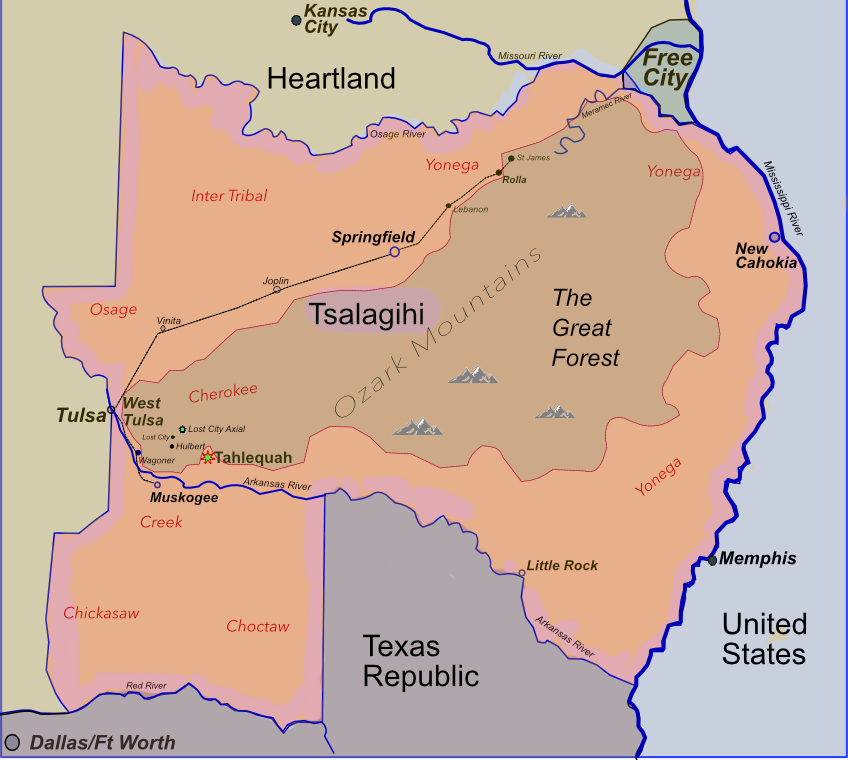Tsalagihi
Universes of the Convergence
Tsalagihi is in the homeland of the Five Nations, in what was once Eastern Oklahoma and parts of Arkansas. It’s capital is Tahlequah.
History
In 2041, near the end of the First Continental War, the Cherokee Nation declared itself the independent Nation of Tsalagihi. It reclaimed all of the original United States treaty lands west of the Mississippi and north of the Arkansas River, including much of northern Arkansas, and Missouri up to the Osage River.
In 2043, the new Texas Republic claimed all of the lands south of the Arkansas River and sent an occupation force into southern Oklahoma, threatening to uproot the Choctaw and Chickasaw tribal lands. The alarmed tribes petitioned the new nation of Tsalagihi to join. Tsalagihi agreed to accept the petitions, along with similar petitions from the Creek, Osage, and Seminole Tribes.
After negotiations, the neighboring tribes were admitted into the United Tribal Council, and the new nation declared itself open to all tribal peoples of the Americas. The new United Tribes, with help from Heartland, pushed back the invading Texans and re-established the Red River as the border.
United Tribes of Oklahoma invited all native tribal members from all tribes to apply for citizenship in the new nation of Tsalagihi (meaning Cherokee Place). The culture is inter-tribal.
Population and Demographics
Population: 12.6 million
The largest cities of Tsalagihi are:
- West Tulsa (1.2 million)
- Tahlequah (823,000)
- Springfield (429,000)
- Little Rock (357,000)
- Muskogee (307,000)
- New Cahokia (276,000)
Government
Tsalagihi has a tribal council form of government, Tsalagihi has seven confederated districts, but national Council of Tribes is based on eight tribal councils, as well as the seven districts., which include an all peoples-council (native immigrants from outside the Nation), a yonega (non-native) council, and six territorial tribal councils: Cherokee, Creek, Choctaw, Chickasaw, Osage, and Seminole. The Yonega Council is the largest, comprising nearly 40% of the population. Due to the flight of many whites after the wars, the native populations represent a majority of approximately 60%.
There are seven self-governing, confederated districts:
- Arkansas District (2.2 million, capital: Little Rock )
- Cherokee District (2.1 million, capital: Tahlequah)
- Kansas District (1.4 million, capital: Joplin)
- Missouri District (2.0 million, capital: New Cahokia)
- Ozark District (1.6 million; capital: Springfield)
- Osage District (.9 million, capital: Pawhuska)
- Three Tribes District (2.4 million; capital: Muskogee)
See: Map of Tsalagihi, 2055.
See: North America, 2055.

Tsalagihi
- AKA Indian Country
- Founded 2041 CE
- Population: 12.9 million
- Seat of Government: Tahlequah
- Government: a form of representative council democracy, with a parliamentary-type structure
- Self-Governing Districts: Arkansas District, Cherokee District, Kansas District, Missouri District, Osage District, Ozark District, Three Tribes District
- Tribal Councils: Cherokee, Creek, Choctaw, Chickasaw, Osage, Seminole, Yonega, InterTribal
- Allies: Heartland, Free Cascadia, Nueva California, Bolivarian Republic of Mexico
- Characters from Tsalagihi: Gabe Proctor, Sylvie Morgan, Leotie Morgan-Hicks, Mercedes Conklin, Bill Ketcher
Political Boundaries

“The Nation of Tsalagihi shall encompass the 1892 boundaries of the Cherokee, Creek, Choctaw, Chickasaw, Seminole, and Osage Nation,
“Plus portions of Kansas and Missouri, as follows: The -96th Parallel up to the Osage River which will form the northern boundary to where the Osage River enters the Missouri River. The Missouri River to the 91st Parallel, down to the Meramec River. East of the 91st parallel, the Meramec River will form the northern boundary to where that river enters the Mississippi River. The Eastern Boundary shall be the Mississippi River, from the mouth of the Meramec to the mouth of the Arkansas River.
“The Southern Border shall be defined as follows: the Arkansas River to the 94th Parallel, then south to the Red River, the west to the western boundary of the Chickasaw Nation, extant in 1892 .”
— Treaty of Free City, 2049, Joe Larivee, principle Mediator